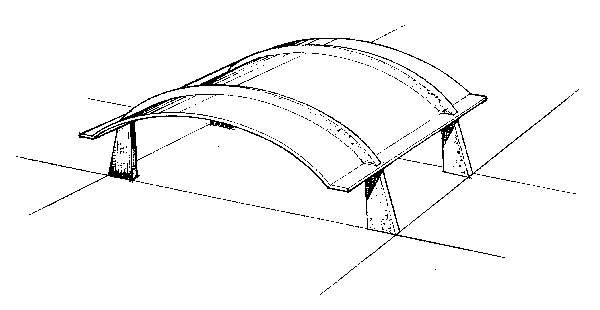Q.
a) Discuss three (3) functional requirements of roof covering for a single storey factory building. (10 marks)
b) With the aid of suitable labelled diagrams, explain the following roof structure for large single storey buildings.
i) Portal frame roof structure
ii) Shell structure (15 marks)
(25 marks, 2012 Q6)
A.
(a) functional requirement of roof for single storey factory.
Similar question was asked in 2015 Q5b here.
(b)
(i) Portal frame roof structure
Similar question was asked in 2015 Q5a(ii) here.
(ii) Shell structure
A thin shell is defined as a shell with a thickness which is small compared to its other dimensions and in which deformations are not large compared to thickness. A primary difference between a shell structure and a plate structure is that, in the unstressed state, the shell structure has curvature as opposed to the plates structure which is flat. Membrane action in a shell is primarily caused by in-plane forces (plane stress), but there may be secondary forces resulting from flexural deformations. Where a flat plate acts similar to a beam with bending and shear stresses, shells are analogous to a cable which resists loads through tensile stresses. The ideal thin shell must be capable of developing both tension and compression.[1]
Types
The most popular types of thin-shell structures are:
- Concrete shell structures, often cast as a monolithic dome or stressed ribbon bridge or saddle roof
- Lattice shell structures, also called gridshell structures, often in the form of a geodesic dome or a hyperboloid structure
- Membrane structures, which include fabric structures and other tensile structures, cable domes, and pneumatic structures.
BASIC ELEMENTS OF SHORT SHELLS
This sketch illustrates some of the principle parts of a short shell structure: 1) the shell spanning between arches, and 2) the arch structure. In this structure, the edge beams are provided at the lowest point of the shell and the arch is placed on top of the shell so that forms may be moved through the barrel. In small structures, the edge beam can be omitted if the shell is thickened. The curve of the shell is determined by the proper shape of the arch and may be a circle for small structures or may conform to the thrust line of the arch for long span structures.
The minimum shell thickness should be at the top in the center of the span. At the arch, the shell thickness is increased slightly for local stresses. The thickness increases toward the springing line of the arch and if not supported by an edge beam, the thickness here should be based on the thickness for a slab spanning the same distance. The edge beams act like the folded plate structures described in the first chapter.
Ref:
Thin-Shell Structure. Wikipedia search 'shell structure for roofing', available at
https://en.wikipedia.org/wiki/Thin-shell_structure
Milo S. Ketchum & Mark A. Ketchum Types and forms of shell structure
http://www.ketchum.org/ShellTandF/index.html

